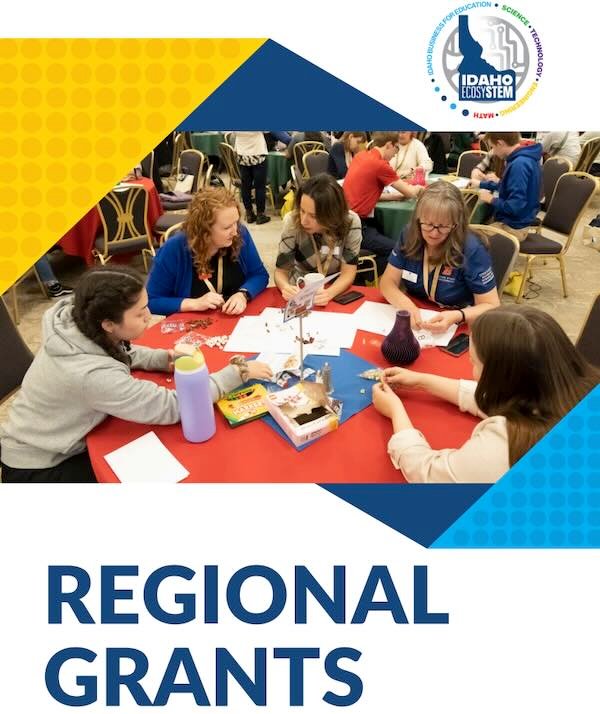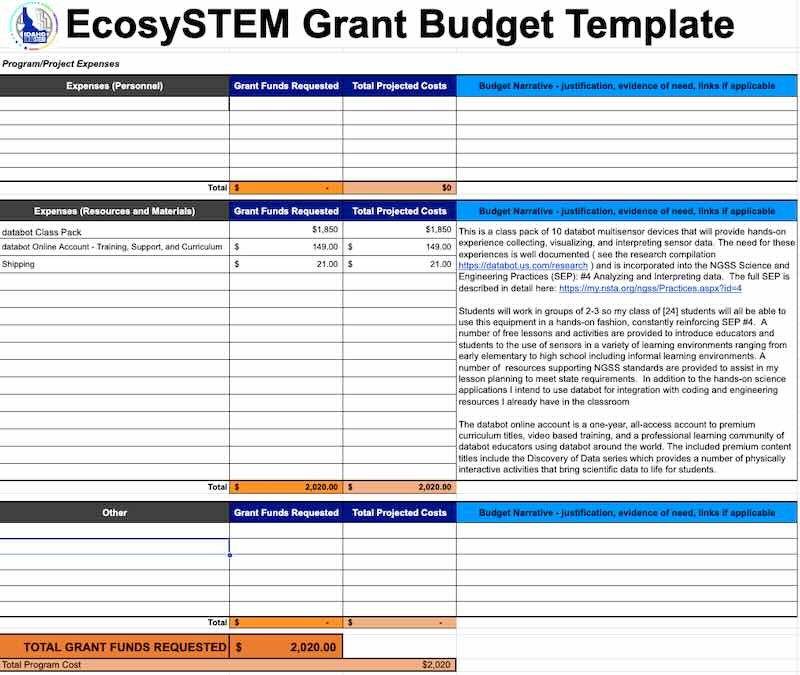Introduction
Greetings Idaho Educators and thanks for your interest in databot! We recently presented at the Idaho Science Teachers Association Conference in Coeur d’Alene and are providing this grant resource page to help those of you who were interested in applying for the Idaho STEM Ecosystem Grant. The following materials summarize the grant process and provide you with resources including research, budget examples, and narrative and copy that you can use to help strengthen your grant application. Feel free to contact us at databot if you have any questions or need additional support. We’re here to help!
Meet the Idaho STEM Ecosystem!
The Idaho STEM Ecosystem is an awesome Idaho initiative!
The Idaho STEM Ecosystem engages partners to foster transformative STEM learning experiences and expand career pathways in every Idaho community.
Idaho STEM Ecosystem Vision
If you have not yet joined the Idaho EcosySTEM online community, visit their site to learn more and sign up. It’s free and it’s a great resource for networking and gaining support for your grant application process! Visit the Idaho EcosySTEM site and join the community to get started.
The Regional Grant Handbook
In the blog post below we have summarized the high points of the Idaho EcosySTEM grant and provide resources for you to draw upon for designing your grant for gaining funding for databot materials. However, to be successful, make sure you read the full grant guidelines carefully! The program is very well documented and will help you at each step to make a successful application. The full guidelines for application can be found here.

Grant Objective, Eligibility, Deadlines, Examples, and Funding Summarized Here
General Objective
Increase access and awareness of inclusive, community-based projects to promote STEM learning and workforce development.
Eligibility
If you are an Idaho public school you are eligible! Also civic organizations, STEM non-profits, and local government agencies. See the full eligibility guidelines in the handbook.
Timeline & Important Dates
There are four rounds of grants in the coming 2024-25 school year, with the following deadlines for each application.
- Round 1: September 8, 2024
- Round 2: November 3, 2024
- Round 3: January 26, 2025
- Round 4: April 13, 2025
Examples of Previously Funded Projects!
- Local school and community STEM nights
- Materials and equipment for makerspaces and STEM learning spaces
- Out-of-School STEM programming, events, and activities
- Program staff and guest speaker stipends
- Professional development for educators
- Materials and equipment for STEM competitions
Funding Amounts
Grants are awarded from $500 – $5,000.
The Application Process Summarized
- Account Setup: Create an account on the grant portal site.
- Login and Access Opportunities. Once logged in you will see the available grants that are available.
- Select Your Program
- Complete Your Application!
Resources to Help You with Your Application
Each application requires you to submit the following information through a straightforward form process. databot has assembled examples and resources to help you fill out the project details.
- Your Organization Information
- Select Your STEM Region
- State the Amount You Are Requesting ($500-$5,000)
- Upload Your Budget (budget template is provided)
- Project Overview (350 characters)
- Project Description (Full description of your project – carefully align it with the provided rubric in the handbook)
- Research Compilation – Why Sensors? A summary of a dozen research projects that focused on the use of sensor technology in the classroom. A variety of use cases are covered with supporting data that shows the effectiveness of real-time data visualization coupled with hands-on experimentation.
- databot class pack plus professional development flyer. This outlines a package that includes databots, training, and all curriculum resources. There are two versions – a 10 databot Class Pack and 15 databot Class Pack (better for 30 students so students are working in pairs)
- databot presentation slide deck. This Canva slide deck includes more in-depth descriptions of databot capabilities, resources, curriculum and software applications. The appendix includes 18 cases studies of databot use in a variety of classrooms ranging from early elementary to high school. The core Canva file is available on request if you’d like to incorporate some of these slides into a presentation you are working on. Contact us!
- Pricing Guide for customizing your budget.
- Budget examples are provided below.
Equity of Access, Diversity, & Inclusion
Making quality STEM accessible to all students is always a high priority issue for high quality educational materials. Grant applications typically include a requirement to address these issues in your project, and the Idaho EcosySTEM opportunity has this embedded in their grant review rubric. The following information can assist you in building a strong case for your databot project.
Equity of Access – Our Four Pillars
databot makes sensor-based science available to all through an affordable, friendly tool with tremendous utility that can easily be shared among K12 educators and students. To address all students and programs we developed a framework, the Democratization of Data, that is embedded in all we do. It is built on four pillars:
Approachability
No technology or pedagogy can be successfully adopted if it is inherently unfriendly, difficult to use, or so fragile you are hesitant to let students use it. We promote friendly, easy-to-use software and hardware that is tough-as-nails. It’s designed for students to handle it, explore it, launch it, and more.
Affordability
databot provides a complete suite of sensors for $189. Compared to traditional probeware it is a fraction the price for similar functionality. Because of this, it is used in many environments that previously had no access. databot also promotes free and open educational resources such as sensor activities that can be done with only a smartphone – no other devices required.
Relevance
databot emphasizes activities with direct connections to careers and real-world applications of sensors. The extensive utility of databot enables it to be easily integrated into many experiences that are relevant to all students including robotics, science, technology, sports, drones, coding, and more.
Engagement
In order to reach all students, science and technology should be engaging. We create data-rich experiences that draw students into the world of science and technology through physical interactions and unique experiences with live sensor data.
Budget
The Idaho EcosySTEM has provided a budget template which makes it very easy for you to build out your financial plan. The template can be downloaded from their site here, it is an Excel file.
databot has constructed two sample budgets using this template that you can download from our site. These include a narrative explaining and justifying the use of the materials that you can adopt, modify, etc. as required for your particular vision. One of the budgets is for a standard class pack of 10 databots that can be shared among students in groups of 2-3. We recommend a 2:1 ratio so students can work together in pairs conducting experiments. The second budget is a 1:1 proposal for 20 databots in a computer lab. If you are using them for computer science and teaching coding, IOT, etc. using laptops, desktops, or Chromebooks we recommend a 1:1 pairing so students can code individually. These examples are provided for your convenience, but know your vision for implementation will be unique. Please use these as a starting point. Download our pricing guide here to customize your own proposal for anything from 1 or 2 bots to more.
Project Overview Examples
Your grant application requires a 350 character overview that succinctly summarizes your project and there are a variety of approaches you can take with your databot project! For technology educators, topics can range from introductory physical computing to advanced topics like IOT and machine learning with students beginning as early as 4th grade with our MicroBlocks drag and drop series. For science educators, elementary and middle school science activities using the range of sensors on board databot are plentiful across all the major science domains – earth science, chemistry, physics, and life science. Environmental science explorations are supported by a number of environmental sensors including air quality – CO2 and VOCs, humidity, light, temperature, sound intensity, UV index, and air pressure. Math educators can use real-time data gathering to bring math concepts to life. Datasets can be easily collected and exported from the included Vizeey app and copied right in to Desmos or CODAP for visualization and analysis. databot can also livestream data directly in Excel or export CSV files for Numbers or Sheets spreadsheet applications. Here are a few examples of sample project overviews to give you some ideas!
Elementary Science
This project brings live sensor data collection and analysis to the elementary classroom using databot, an easy-to-use multi-sensor device. databot, and the included software, provide quick and easy access to a variety of scientific explorations that can significantly improve student comprehension of science concepts. Online PD and support is included.
Shared School Resource
This project brings databot to our school resource center for all of our teachers. databot is highly versatile for teaching coding, science, technology, and math. Sensor games will facilitate lively STEM experiences on our annual STEM night, science explorations will be much more engaging, and our coding club will explore a variety of topics.
Out of School Hours
This project brings thrilling interactions with live sensor data to out-of-school students. databot, a multi-sensor tool, includes 16 sensors and activities that get students leaping, spinning, and cavorting as they explore science topics! Students move like Ninjas, whirl like tops, dance the limbo, and more in this fun-filled program.
High School Science
This project aims to implement databot in a high school physics course as an alternative to traditional probeware. I plan to create and test ten student labs to support the Idaho Science Content standards. If successful, I will share this material with educators statewide, potentially saving schools tens of thousands of dollars in traditional probeware purchases.
Green Teams!
This project will provide databot resources and hardware to our Green Team students who are developing various projects throughout our district supporting sustainability objectives. Projects range from inventorying trees on school campuses to air quality studies in the classroom.
Coding & Robotics: IOT
This project will provide databot coding resources to our High School coding program, providing the technology we need to provide hands-on IOT training. databot is an all-in-one device that can collect a variety of sensor information and easily publish it to a number of IOT services using the included coding resources.
LEGO® Robotics
This project expands our LEGO® Robotics program through the addition of databot resources. The State of Idaho owns a license to the databot Missions with LEGO® Robotics curriculum which significantly increases our student exposure to data collection and application. The eight missions provide direct ties to workplace skills and applications.
K12 Data Science
Data Science is one of the fastest growing career tracks in the world. The ability to understand and interpret data in everything from business to the environment to political polls requires a strong foundation in data literacy. This project introduces K12 students to the basics of data science using engaging, real-time data collected using databot.
Next Steps!
The next step is to dive in and start submitting your application. The full project description should be authored with careful attention to the scoring rubric which is provided in detail in the handbook. Contact us for support and assistance specific to databot to expand on your ideas, confirm capabilities, or just to brainstorm and talk. We’d love to help you in your efforts to bring databot to Idaho classrooms.


